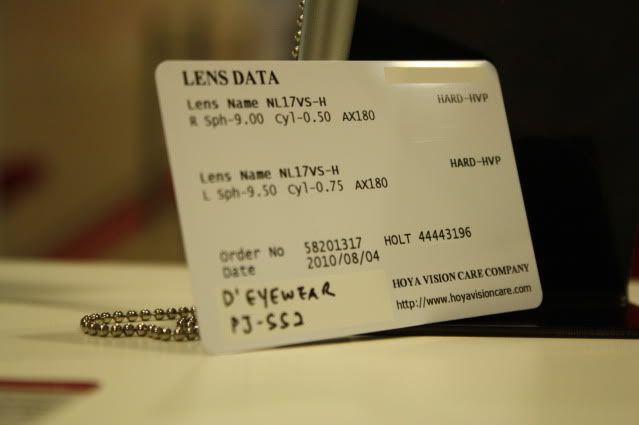QUOTE(Nemozai @ Mar 9 2017, 12:14 AM)
Can I know what is the best index and how much for myopia -8.25 and -9.50, astigmatism C+1.25, C-1.25.
I using Hoya Nulux 1.67 now. Cost me RM 570 with frame. Is it expensive?
I'm not satisfiy, because it's still very thick (approximately 5mm) which make the glasses look very ugly, with all the circular refraction. Can I get my lenses to 1mm? How much?
Hey Nemozai,
I just stumbled across your question in this thread, and I felt like clearing up whatever doubts you might have in regard to the indices of different prescription lenses.
For your information, it is impossible for the lenses to be made as thin as 1mm regardless of how low your prescription is. This is because of something called 'minimum substance' in optics which is basically the minimum thickness of the base material that MUST be added to a lens for the overall structural integrity of the lens. The minimum substance is typically thicker in plastic lenses than glass lenses but you are better off opting for plastic lenses as opposed to the glass material, since glass lenses are more prone to shattering upon impact and thus they are really dangerous as far as your eyes are concerned. Glass lenses have gone obsolete nowadays so it's virtually impossible for you to get glass lenses.
Having that said, the only way to get thinner lenses is getting high-index lenses. As a general rule of thumb, the higher the index, the thinner the lenses as well as the minimum substance. The minimum substance for the most common low-index plastic lens (index = 1.498) CR-39 is 2 to 2.2mm, meaning that the minimum thickness of CR-39 lenses must be 2 to 2.2mm plus the thickness according to your prescription.
A higher index lens needs thinner minimum substance (1-1.5mm).
Based on your statement, it seems like you are very concerned about the thickness of your lenses. Hence, I'd advice you to go for the highest index plastic lens (index = 1.74) if you want the thinnest possible lenses. BESIDES, do bear in mind that there are a few factors that contribute to the thickness of the edge of your lenses. ONE of the most prominent factors being the SIZE and shape of your frame. Because minus lenses are thinnest in the middle (technically the 'optical centre' which is the POINT of a lens that needs to sitting RIGHT in front of your eye, and a dispensing optician is responsible for measuring that up for you) and thickest around the edges.
In brief, the smaller the size of a frame, the thinner the edges of your lenses would be. On the other hand, if you want the lenses to have a better finish (eg. evenly thick around the edges as opposed to the lens being thinner at the top and bottom but thinner at the sides), go for a frame shape that is slightly round-ish / sperical-ish. Avoid frames that are very ANGULAR and RECTANGUAR.
Last but not least, go for PLASTIC frame as opposed to metal frame because plastic frames usually have thicker fronts which can CONCEAL the thickness of the lenses.
To finish, I can briefly work out the possible thickness of your lenses if you were to use the highest-index plastic lens (index=1.74) for the SAME frame that you are having just now:
Let's suppose the minimum thickness for a very high-index lens is 1.5mm and the thickest part of your CURRENT lens is 5mm (old index = 1.67) as what you said above, and you decided to get 1.74 plastic lenses:
3.5mm x (1.67 - 1)/(1.74 - 1) = 3.169 mm
Then the thickest part of your new lens (1.74) = 3.169 . 1.5 = 4.67 mm
5mm to 4.67mm which is a reduction of 0.33mm, not too much of a difference. Hence, I'd really suggest that you get a smaller frame, and you can weigh up whether it's worth the price for 1.74 lenses. Let me know if you have any other question.
*I am an optometry student and I blog about optometry-related stuff. www.thefabvision.comThis post has been edited by thefabvision: Jan 17 2018, 11:07 PM 

 Dec 25 2009, 01:58 PM, updated 16y ago
Dec 25 2009, 01:58 PM, updated 16y ago
 Quote
Quote








 0.0655sec
0.0655sec
 0.55
0.55
 5 queries
5 queries
 GZIP Disabled
GZIP Disabled